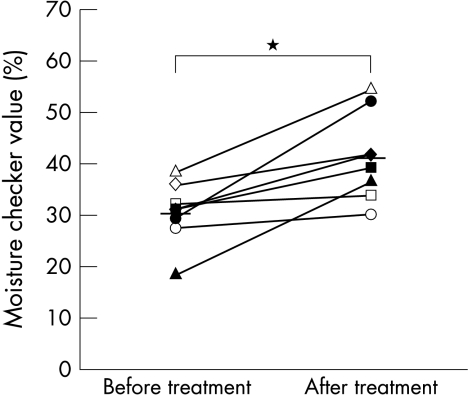Atopic blepharitis is one of the major ocular complications of atopic dermatitis (AD).1,2 It has been pointed out that atopic patients have dry skin accompanied by barrier disruption and water deficiency. Previously, we assessed the water retention ability of eyelid skin by measuring the water content and water evaporation rate from the eyelid in patients with atopic blepharitis.3 The water content positively correlated and water evaporation from the eyelid negatively correlated with the severity of blepharitis.3
Ceramide comprises about 30% of stratum corneum lipids, which have an important role in both the water retention and barrier function of the skin.4 Ceramide abnormalities in several skin disorders, such as AD, have been reported.5,6 Decreased levels of ceramides may be attributable to the insufficient water retention of the skin in AD. Apytt Gel (Zenyaku Kogyo, Tokyo, Japan) is a product containing galactosyl ceramides extracted from horses as a major moisturising ingredient. In this study, we assessed the efficacy and safety of this gel product in patients with mild atopic blepharitis by measuring the water retention ability of the eyelid skin before and after prescription.
Methods and results
Sixteen lids of eight patients (five males and three females, 7∼35 years old, average age 16.0 (SEM 8.4) years) diagnosed as having AD by dermatologists, according to Hanifin and Rajka’s criteria,7 were examined. Because ceramide gel has no anti-inflammatory effect, cases with severe inflammation were excluded from this investigation. After informed consent was obtained, patients were instructed to place Apytt Gel on their eyelids two to five times a day after washing their faces. Assessment of clinical findings using measurement of water retention ability were performed as previously described3 before and 4 weeks after the beginning of application. Statistical analysis was carried out by non-parametric tests (Wilcoxon test). A p value of 0.05 or less was considered statistically significant.
Water content of eyelid skin was significantly increased after treatment (30.6% (6.0%) before treatment, 41.2% (8.5%) after treatment; p<0.025) (Fig 1). Water evaporation values were significantly decreased after treatment (4.5 (1.4) × 10−7 g/cm2/s before treatment, 3.5 (0.9) × 10−7 g/cm2/s after treatment; p<0.05) (Fig 2). No slit lamp findings indicating toxicity were observed during the course of the study.
Figure 1.
The change in water contents of eyelid skin. Water content indicated by moisture checker value is significantly increased after ceramide gel application (bars indicate average value, p<0.025).
Figure 2.
The change in water evaporation rate from eyelid skin. Water evaporation value is significantly decreased after ceramide gel application (bars indicate average value, p<0.05).
Comment
As the eyelid is a borderline lesion between dermatology and ophthalmology with influences on ocular homeostasis, dermatologists often hesitate in prescribing sufficient medication to the eyelids. The assessment and treatment of atopic blepharitis is therefore an important aspect of ophthalmological examination in atopic patients.
Ceramide gel treatment for 4 weeks significantly improved the water retention ability of eyelid skin of patients with mild atopic blepharitis. Among various moisturising products, the application of the ceramide gel is reasonable, because ceramide deficiency has been reported in the skin of atopic patients. Ceramide gel alleviates dryness without stickiness, and patients experience little discomfort. Comfort during application is thought to be one of the important factors for the compliance of patients. Some patients interrupt application of ointments, such as petrolatum (Vaseline), to the eyelid because of stickiness or because the shiny appearance around the eyes is cosmetically conspicuous. Although strong anti-inflammatory drugs are necessary in acute exacerbations of atopic blepharitis, moisturising of the skin using ceramide gel application represents a useful supplementary therapy during periods of relatively light inflammation.
Acknowledgments
The authors wish to thank Ms Mie Sasaki and Ms Saori Nishijima for their assistance in taking measurements of water evaporation from eyelid skin.
Financial support: none.
Proprietary interest: none.
References
- 1.Garrity JA, Liesegang T. Ocular complications of atopic dermatitis. Can J Ophthalmol 1984;19:21–4. [PubMed] [Google Scholar]
- 2.Beltrani VS. The clinical spectrum of atopic dermatitis. J Allergy Clin Immunol 1999;104:S87–98. [DOI] [PubMed] [Google Scholar]
- 3.Asano-Kato N, Fukagawa K, Tsubota K, et al. Quantitative evaluation of atopic blepharitis by scoring of eyelid conditions and measuring the water content of the skin and evaporation from the eyelid surface. Cornea 2001;20:255–9. [DOI] [PubMed] [Google Scholar]
- 4.Brod J. Characterization and physiological role of epidermal lipids. Int J Dermatol 1991;30:84–90. [DOI] [PubMed] [Google Scholar]
- 5.Imokawa G, Abe A, Jin K, et al. Decreased level of ceramides in stratum corneum of atopic dermatitis: an etiologic factor in atopic dry skin? J Invest Dermatol 1991;96:523–6. [DOI] [PubMed] [Google Scholar]
- 6.Jin K, Higaki Y, Takagi Y, et al. Analysis of beta-glucocerebrosidase and ceramidase activities in atopic and aged dry skin. Acta Derm Venereol (Stockh) 1994;74: 337–40. [DOI] [PubMed] [Google Scholar]
- 7.Hanifin JM, Rajka G. Diagnostic features of atopic dermatitis. Acta Derm Venereol (Stockh) 1980;92:44–7. [Google Scholar]




